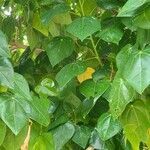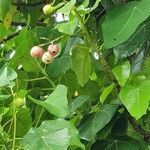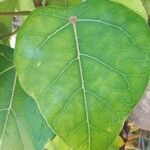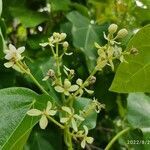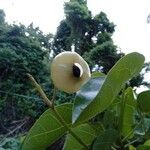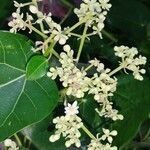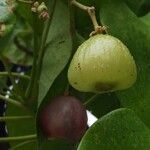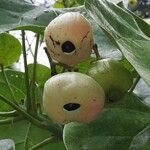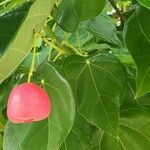Tree or shrub, 3–20 m. tall with spreading crown.. Leaves peltate, ovate, 7–30 cm. long, 6–22 cm. wide, obtuse to shortly acuminate at the apex, broadly rounded to rarely subcordate at the base, subcoriaceous, shining green above, with 8–9 nerves radiating from the base; petiole inserted 1–3 cm. from the lower margin, 5–17 cm. long.. Inflorescences inserted on the secondary or rarely tertiary axes of the thyrse, the flowers white or cream or greenish.. Buds subglobose, 3–3.5 mm. long and wide or rarely ellipsoid and up to 5 mm. long, ochraceous-tomentose.. Male flowers yellowish, 3–merous; filaments minutely puberulous with 2 very short spathulate glands usually connate in pairs between the stamens.. Female flowers 4-merous, the cupule cupuliform to turbinate, ± 2 mm. long with orifice ± 3 mm. wide, the margin truncate or slightly undulate, not constricted below the margin; ovary ovoid, ± 2 mm. long; stigmas orange; glands reddish orange.. Drupe black, ellipsoid, 2.5–3 cm. long, 1.7–2.3 cm. wide, with an apical boss 8–10 mm. wide, 2–3 mm. tall, not or very shortly stipitate at the base, slightly 8-ribbed, included in an inflated white, pinkish or rarely red cupule with a round orifice with slightly revolute margin.. Fig. 1.
Tree to 15 (–18) m high; stems glabrous. Leaves with petiole 6–25 cm long inserted 1–4 cm above base margin; lamina broadly ovate, bluntly acuminate, peltate, 10–30 cm long, 7–15 cm wide, coriaceous, glabrous, 3-veined at base. Panicle to 25 cm long; peduncle 7–18 cm long, glabrescent. Involucral bracts 4, obovate, 3–5 mm long, greenish white. Perianth segments elliptic, 4–6 mm long, minutely pubescent, white. Male flowers: pedicel c. 3 mm long; perianth segments 6; stamens 3. Female flowers: pedicel c. 2 mm; cupule c. 2 mm long; perianth segments 8; ovary c. 2 mm long; style straight. Fruit subglobular to ovoid, 8-ribbed with a rounded apical protuberance, 20–28 mm long, black; fruiting cupule ± broadly obovate, 2–3 cm long, translucent white, ageing pink; aperture 8–12 mm diam. See also Cooper & Cooper (2004: 229–230), Zich et al. (2020).
Trees. Bark smooth. Petiole nearly as long as blade; leaf blade peltate, ovate or orbicular-cordate, 20-40 × 15-30 cm, papery, glabrous, 3-7-veined, base rounded and cordate, apex acute. Peduncle 6-20 cm. Panicle axillary; involucral bracts 4, elliptic to obovate, 2-6 × 1-3.5 mm. Flowers axillary, 3 together in a corymb, lateral flowers staminate, central one pistil-late. Staminate flowers: pedicel tomentose; tepals 6, in 2 series; stamens 3; filaments with 2 basal glands, ca. 1 mm. Pistillate flowers: pedicel absent; tepals 8, in 2 series; style ca. 3 mm, papillose; stigma dilated, irregularly toothed; surrounding glands 4, ca. 1 mm. Fruit drupaceous, urn-shaped, costate, 3-4 cm in diam. Fl. and fr. year-round. 2n = 40.
A tree. The bark is smooth. The leaves are oval to heart-shaped. They are 20-40 cm long by 15-30 cm wide. The flowers are in the axils of the leaves. The fruit is fleshy and urn shaped. They are 3-4 cm across.
